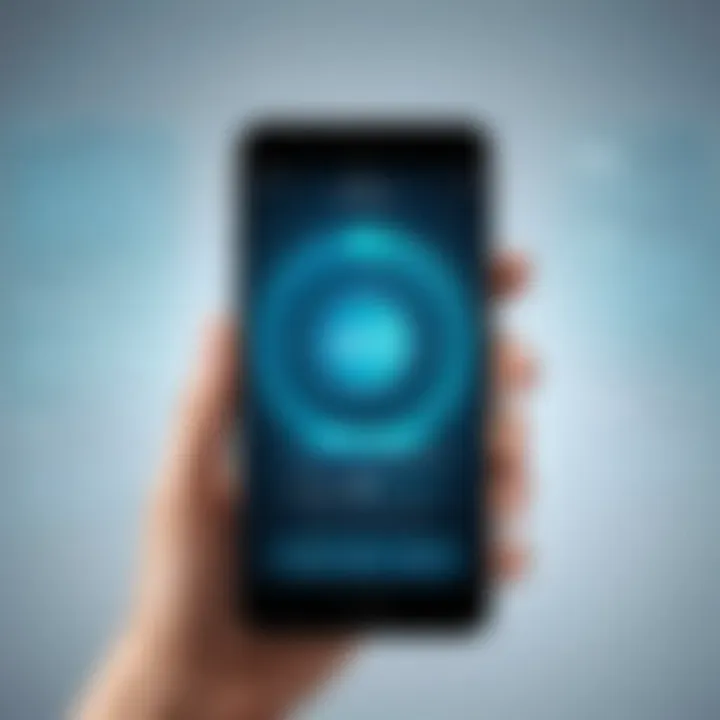Boosting Customer Loyalty with Upserve Insights


Intro
In the competitive arena of the hospitality industry, retaining customers is as crucial as attracting new ones. With the market evolving at an impressive pace, business owners seek innovative solutions to bolster their customer loyalty initiatives. Upserve stands out as a potent tool tailored specifically for this sector, combining cutting-edge technology with insightful data analytics. By employing this platform, establishments can not only engage their visitors more effectively but also fine-tune their service offerings to align closely with customer expectations.
Adopting a holistic approach with Upserve equips hospitality professionals with the insights needed to form genuine connections with patrons. This article seeks to dissect the features and functionalities integral to Upserve, illustrate how these can effectuate customer loyalty, and provide decision-makers with pragmatic strategies to leverage this technology within their operations.
Understanding Customer Loyalty
Understanding customer loyalty isn't just a buzzword; it's the backbone of repeat business and sustained growth in the hospitality industry. In a crowded market where choices are abundant, the ability to foster loyalty can distinguish a thriving venue from one that's just scraping by. Customer loyalty brings about numerous benefits, from increased revenue to enhanced brand reputation. It's about creating lasting connections with clientele, allowing businesses to weather economic fluctuations more robustly.
Definition and Importance
At its core, customer loyalty refers to a customer's commitment to repurchase from a brand consistently over time. It’s more than just satisfaction; it's a deeper emotional bond between the customer and the establishment. For instance, a family that returns to the same restaurant for anniversaries or special occasions is demonstrating loyalty that goes beyond mere dining choices. This bond can translate into several advantages:
- Repeat Business: Loyal customers are more likely to return, providing a steady revenue stream.
- Word-of-Mouth Promotion: Happy patrons often share their experiences with friends and on social media, driving organic growth.
- Lower Marketing Costs: Retaining existing customers is often less costly than acquiring new ones, freeing up resources for other initiatives.
Building this relationship takes effort, but the payoff can be substantial. As Upserve integrates itself into operational frameworks, understanding customer loyalty becomes more manageable, introducing systems that recognize and reward loyal customers.
Factors Influencing Loyalty
A multitude of factors can influence customer loyalty, often intertwining to create intricate loyalty dynamics.
- Quality of Service: Exceptional service can make a world of difference. A server who remembers a customer's name or favorite dish creates a more personal experience.
- Consistency: Guests tend to flock back when they can expect the same level of quality time after time. Imagine walking into a café, only to find that your favorite pastry has been replaced by something entirely different. This inconsistency can erode trust.
- Personalization: Tailoring offers and services to individual preferences nurtures customer loyalty. For instance, if a diner receives a tailored email offering discount on their favorite dish, that can make them feel valued.
- Community Engagement: Businesses that engage with their local communities often see a more dedicated customer base. Supporting local events or charities can cement a business's role in the neighborhood, inviting patronage beyond just business transactions.
In the digital age, technology plays a pivotal role in these factors. Platforms like Upserve can help businesses collect and analyze vast amounts of data about their customers, crafting a more responsive and personalized experience.
"Loyalty is not about being best friends; it’s about creating an experience that keeps your customers coming back for more."
Understanding what drives loyalty equips businesses to design strategies that not only attract but also retain customers. With Upserve's tools and insights, the way forward becomes clearer, paving the path to stronger customer relationships that endure.
Overview of Upserve
The significance of delving into the functionalities and capabilities of Upserve cannot be overstated, especially for those looking to boost customer loyalty in the hospitality sector. Upserve provides a robust platform that integrates vital information and insights to enhance the dining experience and reinforce customer relationships. Understanding what makes Upserve stand out is essential for decision-makers and IT professionals aiming to harness its full potential.
What is Upserve?
Upserve is an all-encompassing restaurant management system that combines point-of-sale (POS) functionality with comprehensive analytics and customer relationship management tools. Designed with the nuances of the hospitality industry in mind, Upserve caters to an array of business sizes—from cozy cafes to bustling fine dining establishments.
"Upserve empowers restaurants to thrive by providing tools that not only handle transactions but also deliver actionable insights."
One of its primary benefits is the ability to consolidate various operational aspects—like ordering, payments, and customer feedback—into a single interface. This streamlining allows restaurant owners and managers to focus less on day-to-day mechanics and more on strategies that foster customer loyalty.
Core Features of Upserve
The core features of Upserve are designed to create a seamless experience for both operators and customers. By harnessing data effectively, it opens up avenues for targeted marketing and personalized service,
- Integrated POS System: At the heart of Upserve is its intuitive point-of-sale system, which is user-friendly and efficient. This enhances transaction speed and accuracy, ultimately improving customer satisfaction.
- Analytics Dashboard: The built-in analytics dashboard provides real-time insights regarding sales trends, customer preferences, and operational performance. This data can shape marketing strategies and menu adjustments, which can significantly drive loyalty.
- Customer Profiles: Upserve allows the creation of detailed customer profiles. By tracking previous orders and preferences, restaurants can personalize interactions and offer tailored promotions that resonate with individual patrons.
- Mobile Access: With Upserve's cloud-based system, users can access vital information anytime, anywhere—from managing reservations to analyzing sales data. This flexibility empowers restaurant decision-makers to respond to evolving circumstances promptly.
- Integrated Marketing Tools: Upserve also features marketing automation that aids restaurants in reaching out to customers through email campaigns, loyalty promotions, and feedback solicitation, all designed to maintain customer interest and engagement.
The correct implementation of Upserve transcends mere operational enhancement; it fosters a deeper understanding of customer behavior and preferences, essential components in a successful strategy to engender loyalty. By leveraging these tools, hospitality businesses can create a robust framework that prioritizes customer satisfaction, ultimately leading to sustained loyalty.
The Role of Technology in Loyalty Programs
The landscape of customer loyalty is rapidly reshaping, driven by the advancements in technology. For hospitality businesses, embracing technological solutions isn't merely an option; it's a necessity. Tech tools like Upserve play a crucial role in crafting loyalty programs that resonate with customers and keep them coming back for more. By integrating technology into loyalty strategies, businesses can foster a more personalized, engaging experience that meets the ever-evolving needs and expectations of today's consumers.
Digital Transformation in Hospitality


Digital transformation in the hospitality sector has become the bread and butter for businesses aiming to stay competitive. Today’s guests expect seamless experiences—from the moment they book their stay to the time they check out. With platforms like Upserve, hospitality businesses can streamline processes, allowing for a smoother interaction between staff and customers.
Enhancing your setup with smart point-of-sale systems, mobile apps, and integrated feedback tools can drastically change guest perceptions. For instance, imagine a diner receiving a personalized discount on their favorite dish because of a loyalty program directly linked to their purchase history. That's tech in action. Here are some key elements of a digital transformation:
- Automation of Tasks: Minimizing manual processes can free up staff, enabling them to provide better customer service.
- Real-time Data Access: This helps in anticipating customer needs effectively.
- Improved Customer Interactions: With technology, hotels and restaurants can engage with guests more efficiently, be it through SMS updates or personalized emails.
The importance of getting this right is immeasurable. It’s one thing to have guests come through the door; it’s another to establish a lasting relationship that turns a one-time visitor into a loyal patron.
Data Analytics for Customer Insights
In today’s world, data is the new gold. This is especially true for hospitality businesses employing loyalty programs. By utilizing data analytics tools offered by Upserve, managers can glean invaluable insights into customer preferences, purchasing patterns, and feedback.
Benefits of Data-Driven Insights:
- Understanding Customer Behavior: Analytics allows businesses to identify which promotions work and which don’t. This can enable them to tailor their offerings effectively.
- Segmenting Customers: By categorizing customers based on behavior, businesses can craft personalized marketing strategies that are more likely to resonate.
- Optimizing Operations: Understanding peak hours or popular menu items through data can streamline operations, reducing wait times and enhancing customer experience.
For instance, employing machine learning algorithms can help anticipate future trends, allowing establishments to adjust their menu or services proactively. If many visitors order a particular drink, it might be time to introduce a loyalty program focused on that item, boosting sales while nurturing customer relationships.
"In an age where choices are abundant, data analytics plays a pivotal role in ensuring that businesses stand out in a crowded marketplace."
Implementing Upserve for Customer Loyalty
Implementing Upserve goes beyond just adopting a software solution; it's about transforming how a business interacts with its customers. The hospitality landscape grows ever more competitive, and customer loyalty is often the lifeblood of a successful operation. By integrating Upserve, establishments can improve customer relationships, enhance satisfaction, and, ultimately, drive repeat business. An effective implementation strategy involves understanding the platform's capabilities and aligning them with the unique needs of the business.
Strategizing Customer Engagement
Engaging customers effectively means leveraging every interaction, from the first greeting at the door to post-visit follow-ups. One key aspect of Upserve is its ability to gather customer data at all touchpoints. This includes preferences, behaviors, and feedback. By analyzing this data, businesses can craft tailored experiences that resonate with their guests. For instance, if a regular patron frequently orders a specific dish, the staff can ensure it’s highlighted in their next visit or even customized to their liking.
Moreover, integrating a customer feedback system into the Upserve interface allows businesses to capture real-time insights. This two-way communication fosters a sense of community and ensures guests feel heard.
"Customer engagement isn't a one-time effort; it needs to be nurtured like a fine wine - with patience and care."
To implement effective customer engagement strategies, consider the following:
- Personalization: Automate personalized messages for special occasions like birthdays or anniversaries.
- Promotions: Use Upserve to set up targeted promotions based on customer preferences.
- Active Listening: Regularly analyze customer feedback to fine-tune the experience based on what guests communicate.
Integrating Loyalty Programs with Upserve
Loyalty programs are proven tools for retaining customers, but their integration with operational systems can often be a hurdle. With Upserve, businesses can seamlessly integrate loyalty programs into their point-of-sale systems. This integration allows for real-time tracking of points, rewards, and customer status, making participation easy for consumers and improving engagement.
The benefits of this integration are significant: it not only reduces friction in interactions but also encourages ongoing interaction with the program. Customers can access their loyalty status instantly and may be more inclined to return to earn their next reward. Establishments can use this data to inform marketing strategies, tailoring offerings to keep the momentum alive. Here are some considerations for successful integration:
- Training Staff: Ensure all employees understand how the loyalty system works, so they can promote it during customer interactions.
- Prominent Display: Use physical signage as well as digital menus to promote the loyalty program and highlight benefits clearly.
- Value-Driven Rewards: Choose rewards that genuinely resonate with the clientele, ensuring they provide real value.
Case Studies of Successful Upserve Implementations
Case studies offer a treasure trove of data that brings real-world applications of Upserve to light. Looking at concrete examples enables us to distill information about what works, what doesn't, and how various players maneuver in the competitive hospitality landscape.
Small Business Success Stories
When it comes to small businesses, the agility and personal touch they offer often distinguishes them from larger competitors. One such success story is a quaint cafe nestled in a bustling neighborhood. This establishment started using Upserve’s tools to better understand customer preferences. With data analytics at their disposal, they discovered that certain menu items were particularly popular on weekends. This insight allowed them to tailor their specials, driving traffic during slower hours. Furthermore, they implemented a loyalty program within Upserve, rewarding frequent customers with discounts. As a result, foot traffic increased by 25% and customer satisfaction ratings soared.
Another example features a family-run pizzeria that ramped up its game with Upserve’s integrated point-of-sale system. By leveraging customer feedback mechanisms embedded in Upserve, they were able to address complaints and gather suggestions. This proactive approach turned negative experiences into positive ones, leading to an increase in repeat business. A direct correlation was noted, with revenues jumping 40% in just a few months. These small business case studies illustrate the dramatic impact that tailored technology solutions can have, underscoring the importance of understanding one’s customer base.
Enterprise-Level Achievements


On the other end of the spectrum, enterprise-level establishments have leveraged Upserve’s capabilities to streamline operations and enhance customer loyalty. For instance, consider a well-known hotel chain that utilizes Upserve for its restaurant and bar tracks. They harnessed the system’s powerful data analytics to create individualized dining experiences. By analyzing guests' past orders and preferences, the culinary team crafted bespoke menus that catered to recurring guests, which fostered a sense of personal connection. In the realm of luxury hospitality, such tailored experiences are gold.
Another enterprise-level example involves a global restaurant brand that took advantage of Upserve’s marketing tools. After analyzing customer behaviors and seasonal trends, they launched targeted campaigns that aligned with customer desires, boosting engagement rates. The integration of loyalty programs led to a marked increase in membership sign-ups, as diners were drawn in by the promise of rewards. This holistic approach not only enhanced customer loyalty but also resulted in a 30% increase in revenue over the course of a year.
"The biggest lesson from these case studies is that both small and large institutions can benefit enormously from adopting Upserve, though the specific strategies may vary depending on their unique contexts."
As a whole, these case studies clarify the wide-reaching benefits of utilizing Upserve across different scales and types of businesses. The path to customer loyalty is significantly guided by understanding and acting upon data-driven insights, making Upserve a key player in any hospitality professional’s arsenal.
Evaluating Success Metrics
When it comes to customer loyalty, understanding how successful your initiatives are can be the differentiator between thriving and merely surviving in a competitive market. Evaluating success metrics provides insights that go beyond surface-level observations. It allows hospitality businesses to make informed decisions, adapt strategies, and ultimately enhance customer loyalty through tools like Upserve.
The effectiveness of loyalty programs is closely tied to how well they resonate with customers. Proper evaluation enables businesses to identify what works, what doesn’t, and where there’s room for improvement. Focusing on specific elements of evaluation can bring notable benefits:
- Better Resource Allocation: By knowing which metrics actually correlate with customer loyalty, businesses can allocate their resources more efficiently.
- Enhanced Customer Insights: Metrics provide a window into customer behavior, preferences, and trends that organizations can analyze to fine-tune their loyalty initiatives.
- Proactive vs. Reactive Strategies: By continuously monitoring these success metrics, businesses can shift gears proactively instead of waiting to react only when loyalty rates decline.
In the case of Upserve, emphasizing success metrics not only aligns loyalty programs with customer expectations but also drives business growth and profitability.
Key Performance Indicators
Key performance indicators (KPIs) serve as vital signs for evaluating the health and effectiveness of loyalty programs. Without clear KPIs, it’s like driving blind into a winding road without a GPS. To effectively utilize Upserve for enhancing customer loyalty, here are several key metrics to consider:
- Customer Retention Rate: This is a straightforward indicator that reveals the proportion of customers engaged with the business over a specific time frame. A higher retention rate generally signifies better loyalty and satisfaction.
- Customer Lifetime Value (CLV): Understanding how much revenue an average customer generates over time can help hone marketing strategies and loyalty programs to maximize this value.
- Frequency of Visits: Tracking how often loyal customers return can grant valuable insights into how effective current engagement strategies are.
- Net Promoter Score (NPS): This simple survey measures customer satisfaction and their likelihood of recommending your brand to others. A positive NPS is often a solid indicator of strong customer loyalty.
Implementing these KPIs using Upserve can provide a clear picture of customer behaviors and preferences, making it easier to make data-driven adjustments.
Customer Feedback Mechanisms
To create a solid foundation for customer loyalty, listening to customer feedback is key. Organizations should view feedback not just as comments, but as treasure chests filled with valuable data. Effective mechanisms for collecting and analyzing customer feedback can manifest in several ways:
- Surveys and Questionnaires: Simple yet effective, these can be integrated into platforms like Upserve to gather insights from customers after their dining experience. Just a few well-phrased questions can extract a wealth of information.
- Online Reviews and Social Media Feedback: Today, feedback is often out there for everyone to see. Monitoring platforms like Facebook and sites like Yelp can provide real-time data on customer sentiment and expectations.
- Focus Groups and Interviews: While slightly more involved, these can yield in-depth insights. A moderated discussion offers customers a chance to go beyond surface-level feedback, providing qualitative data that’s often richer.
- In-App Feedback Tools: Upserve can incorporate in-app feedback prompts during the dining experience itself, allowing for immediate reactions when the experience is fresh in customers’ minds.
By leveraging these feedback mechanisms, businesses can spot trends and necessary improvements quickly. This not only helps adapt loyalty programs but also builds a connection with customers, making them feel seen and valued, further fortifying their loyalty.
Challenges in Implementing Upserve
Implementing Upserve can often seem like a walk in the park, but for many businesses in the hospitality sector, it's not all sunshine and rainbows. This section uncovers the hurdles that decision-makers may face during this journey, helping them envision the landscape ahead.
Common Obstacles
Many businesses encounter a variety of obstacles when integrating Upserve into their operations. Here are some key challenges that often arise:
- Resistance to Change: Employees may be resistant to new systems and processes. Change can be daunting, and if the existing processes seem comfortable, they may balk at adopting new technology.
- Insufficient Training: Just like a chain is only as strong as its weakest link, a loyalty program’s effectiveness is contingent on the proficiency of those operating it. Without adequate training, staff may struggle to utilize the software properly, which can lead to decreased efficiency and customer dissatisfaction.
- Integration Issues: Connecting Upserve with existing systems can be tricky. Businesses often use various software solutions, and getting them all to communicate well can sometimes feel like herding cats.
- Cost Implications: For smaller businesses, the financial toll of adopting a comprehensive system like Upserve can be significant. There’s often a fear of investing money upfront without a clear understanding of the potential return on investment.
- Data Security Concerns: With increasing regulations around data privacy, there’s also a legitimate concern about how customer data will be managed and secured. Companies must ensure they're adhering to standards like GDPR, which can complicate matters further.
Strategies for Overcoming Challenges
Knowing the challenges is just half the battle; crafting strategies to overcome them is crucial for ensuring a successful implementation. Here are some approaches that can pave the way:
- Effective Communication: Clear communication can help ease the transition. Engaging with staff early on and explaining the benefits of Upserve helps cultivate buy-in among employees. When people understand how the system makes their lives easier, they'll more likely embrace it.
- Comprehensive Training Programs: Invest in training sessions that allow all employees to become well-versed in utilizing the software. Hands-on training and real-life scenario exercises can empower staff members to tackle the platform with confidence.
- Gradual Integration: Instead of a full-on switch to Upserve, consider a gradual integration approach. This can ease the learning curve, allowing employees to become comfortable with the system before moving on to more advanced features.
- Budgeting for Hidden Costs: Being transparent about costs related to the implementation of Upserve can mitigate financial concerns. It’s essential to create a budget that includes not only the initial costs but also training and potential system upgrades in the future.
- Prioritize Data Protection: Take the necessary steps to reassure customers that their data is in safe hands by implementing robust security measures and being transparent about data management practices. Building trust in data handling can help alleviate fears around data privacy and security.
Future Trends in Customer Loyalty
The landscape of customer loyalty is evolving at pace, driven by rapid advancements in technology and shifting consumer expectations. Understanding future trends in customer loyalty is vital for any business looking to maintain its competitive edge. As we move forward, businesses in the hospitality sector like restaurants and hotels must grasp the intricacies of these trends to foster deeper connections with their customers.
Emerging Technologies


Emerging technologies are reshaping how businesses engage with their customers. Innovations like artificial intelligence and machine learning are not only enhancing customer experience but also streamlining loyalty programs.
- Personalization at Scale: Leveraging AI can enable restaurants to analyze customer data more deeply, yielding insights that help tailor marketing efforts. For instance, if a diner frequently orders vegan dishes, targeted promotions can be automatically generated to showcase similar menu items.
- Mobile Engagement: With most people glued to their smartphones, a mobile-first loyalty strategy can revolutionize engagement. Using app-based systems allows for real-time push notifications, encouraging repeat visits by reminding customers of their loyalty points or exclusive offers.
- Blockchain for Transparency: Blockchain technology can enhance trust by providing verifiable records of loyalty points and transactions. Instead of fearing point expiration or fraudulent redemptions, customers can have a clear understanding of their earned rewards.
These technologies not only create a more efficient engagement process but also enrich the customer experience by understanding and anticipating needs. In this fast-paced world, it's crucial to stay ahead of the curve and be willing to experiment with these innovative tools.
Evolving Consumer Expectations
Recent shifts in consumer behavior reveal a growing demand for authenticity and values-driven engagement. Today's customers aren't merely content with transactional relationships; they seek connections that resonate on a deeper level.
- Sustainability Matters: Many consumers now prefer brands that align with their personal values—be it environmental concern or social justice. Implementing loyalty programs that reward sustainable choices can create a sense of community and foster loyalty.
- Instant Gratification: Modern diners expect immediate rewards. If someone takes the time to engage with a loyalty program, they want prompt recognition of their efforts. Offering instant redeemable rewards could turn a casual visitor into a regular patron.
- Increased Transparency: Consumers today care about how loyalty programs work. An open communication channel explaining policies and benefits ensures customers feel valued. If businesses reach out after every interaction, whether positive or negative, customers' loyalty is likely to stabilize.
"Customer loyalty isn't just about rewards; it's about creating an emotional bond that goes beyond the transaction."
Recommendations for Industry Professionals
When it comes to boosting customer loyalty, industry professionals must grasp that the stakes are high. In today’s hospitality landscape, where choices abound, fostering strong connections with customers can make or break a business. For decision-makers, this section provides vital insights into enhancing loyalty through Upserve, a platform uniquely suited for this purpose. Knowing how to leverage technology to create meaningful customer experiences is paramount.
Tailored Approaches for Advisors
Advisors play a critical role in guiding businesses toward implementing effective loyalty programs. Tailoring your approach to each client's specific needs is essential. Here are some strategies:
- Understand the Audience: Dive into the demographics and preferences of the client’s customer base. What do they value? Knowing what piques their interest can direct loyalty strategies in the right way.
- Personalize Interactions: Upserve’s tools enable businesses to gather customer data and customize interactions. This personal touch isn't just icing on the cake; it’s what keeps customers returning for seconds.
- Align Strategies with Goals: It’s vital to know the client’s business goals. Whether it’s increasing repeat visits or enhancing average spend, aligning loyalty tactics with these objectives ensures a focused approach.
By taking these tailored approaches, advisors can help their clients navigate the complexities of customer loyalty programs seamlessly, making the most of Upserve’s capabilities.
Best Practices for Software Buyers
When looking into software like Upserve, buyers should be equipped with a checklist to make informed decisions. Here are best practices to consider:
- Assess Your Needs: What are the specific pain points the software needs to address? A clear understanding will avoid unnecessary purchases and ensure value for money.
- Explore Scalability: As businesses grow, their needs change. Choose a platform that grows alongside the business, offering new features without a costly migration.
- Check Integration Capabilities: Upserve works best when it integrates seamlessly with existing systems. Ensure that it can communicate effectively with other tools in use—this can save a ton of headaches later.
- Prioritize User Experience: The software should be user-friendly, enabling staff to adopt it without extensive training. An intuitive interface can reduce resistance and foster enthusiastic usage.
- Evaluate Customer Support: Reliable customer support is crucial. A platform’s effectiveness can be heavily influenced by the quality of assistance available when issues arise.
By adhering to these practices, software buyers can make savvy decisions that drive both customer loyalty and operational efficiency.
"Connecting the dots between technology and customer experience is essential for loyalty in today's market."
In sum, addressing these pivotal recommendations allows industry professionals to enhance customer loyalty effectively. With Upserve at the center, the pathway to nurturing lasting relationships in the hospitality sector becomes clearer.
End
The conclusion of this article underscores the pivotal role that Upserve plays in nourishing customer loyalty within the hospitality industry. In an age where options are abundant and competition is fierce, insights from this discussion reveal layers of strategic advantage. Leveraging technology not only enhances customer interactions but also lays the groundwork for sustained engagement.
Through integrating Upserve into loyalty efforts, businesses transform data into actionable insights, creating tailored experiences that resonate with their patrons. The depth of analytics that Upserve offers turns mere numbers into narratives; these narratives guide decision-making and refine customer journey pathways. The benefits extend beyond just retaining existing customers; they foster a loyalty culture that can drive profitability and brand advocacy.
Key considerations outlined throughout emphasize that simply having a loyalty program isn't sufficient. Instead, it's about continuity in engagement, personalization of services, and a proactive understanding of customer preferences. By placing these elements at the forefront, businesses can create a symbiotic relationship, where customer expectations align seamlessly with operational offerings.
"Customer loyalty is not a random act; it’s a systematic approach that requires dedication and foresight."
Both the specifics of implementation and the analysis of successful case studies presented illustrate that results are tangible when devotion to customer satisfaction meets sophisticated technology. This paradigm shift is no longer an option but a necessity for thriving in the hospitality sector.
Summarizing Key Takeaways
- Advanced Analytics: Utilizing Upserve's robust analytics enables businesses to extract valuable customer insights, making it easier to anticipate their needs and preferences.
- Engagement Strategies: Implementing tailored engagement strategies using Upserve can significantly enhance the customer's experience, thereby bolstering loyalty.
- Proven Success: Case studies have shown that companies using Upserve effectively witness improved retention rates and higher customer satisfaction scores.
- Continuous Adaptation: Adapting to emerging trends in consumer behavior is vital. Regularly revisiting loyalty programs ensures they remain relevant and impactful.
The Path Forward
Looking ahead, the emphasis on customer loyalty through technology, particularly with platforms such as Upserve, is only set to intensify. Here are some potential paths and considerations for industry professionals:
- Invest in Training: Firms must prioritize staff training to fully utilize Upserve’s capabilities. This will enable seamless integration of technology into day-to-day operations.
- Cycle of Feedback: Establishing a continuous feedback loop can refine services offered, allowing for tweaks that resonate more deeply with customer desires.
- Scalable Solutions: As businesses grow, ensuring that systems like Upserve can scale effectively is crucial. Being nimble can help sustain loyalty during transitions.
- Cross-Channel Engagement: Expanding loyalty efforts across various channels, such as social media and email, can create a more cohesive customer approach.
Maintaining foresight here is critical. The hospitality landscape is evolving, and as technology progresses, so too will the expectations of customers. Ensuring that loyalty programs remain adaptable will be key to retaining competitive edge.















